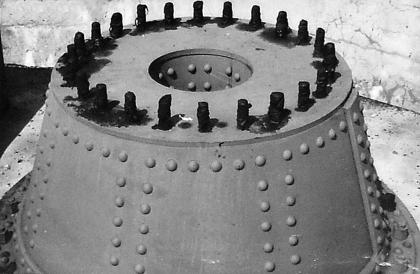The Miiduranna Coastal Battery
The Miiduranna coastal battery was created in 1914–1915 as part of the Naval Fortress of Emperor Peter the Great. Later the battery was part of the Estonian coastal defense. In 1940, the battery passed into the hands of the Soviet occupation forces, and in August 1941, the retreating Soviets dismantled and took away the guns, and the concrete structures of the battery were blown up.
In connection with the construction of the Emperor Peter the Great Port, a new grandiose naval base in Tallinn, it was also planned to build coastal defense batteries around the city that belonged to the Emperor Peter the Great Sea Fortress system. According to the 1913 project, it was planned to build three coastal batteries on the Viimsi Peninsula, one of them on the Miiduranna Hill on the western coast of the peninsula.
The battery named No. 13 and consisted of four concrete gun casemates, and a fire control casemate. On July 27, 1914, the four 120-mm guns were installed on the battery. In August 1916, anti-aircraft battery No. 13a was put into operation nearby, armed with 3x75 mm guns, which were removed from battery No. 12a on the island of Suur-Paljassaar. Two searchlight stations were also installed for the batteries - station No. 8 and No. 9. In April 1917, one 120 mm gun was removed from the battery and sent to battery No. 3b on the island of Väike-Pakri.
In February 1918, during the offensive of the Imperial German troops, the gun casemate No. 4 was blown up by the retreating Bolsheviks. During the first German occupation, the Miiduranna batteries were not used, but all guns were removed from them.
In the autumn of 1922, Estonian troops re-commissioned the Miiduranna battery, but an attempt to place 6-inch (152 mm) guns there failed. In the Estonian coastal defense system, the battery became No. 7, since this number remained vacant from the Meriküla battery in Virumaa, which existed between 1919 and 1922.
Together with other batteries on the Viimsi peninsula, since 1927 it belonged to the coastal defense system of the island of Aegna. In 1926 the battery was armed with three 120 mm Vickers guns. The gun casemate No. 4, destroyed in 1918, was not restored. Now the battery was a reserve one, with only guarding crew. In the summer, the battery area was used by the anti-aircraft artillery battalion for the summer training camp; for the winter, the guns were returned to their permanent location in Kalamaja in Tallinn.
In the summer of 1940, after the occupation and annexation of Estonia by the USSR, the batteries of the Estonian coastal defense were transferred to the Soviet military system. The battery received No. 185 in September 1940. According to Soviet military engineers and coastal artillerymen, the battery was unsuitable for the Soviet system, and it was planned rearm with 4x100 mm guns. The new guns did not fit on the old bases, and new concrete bases for the guns were poured in front of the old parapets. In the summer of 1941 the battery was used in the Soviet defense of Tallinn against invading German troops. During the retreat from Tallinn on August 28, 1941, the guns were transferred to armored trains, and two gun casemates were blown up and other structures were damaged.
The Germans did not restore the batteries, but in the autumn of 1941 a German unit of military engineers examined and measured the batteries, the results of which were published in Berlin in January 1942 in the collection „Denkschrift über die russische Landesbefestigung“ (albeit with large errors). At the beginning of 1944, the Germans installed an 8-gun anti-aircraft battery nearby and to the north of the battery, on Rohuneeme, large-caliber anti-ship battery No. 1 „Prince Henry“ (Prinz Heinrich; 2x280 mm), which was subordinate to the 530th naval artillery division and was supposed to defend both the Aegna and Prangli Islands, the eastern coast of the Viimsi peninsula, and the entire Ihasalu Bay.
After the war, the batteries were not restored. However, in the second half of the 1990s, the previously curvy road was straightened, and now the new road passed directly above the gun casemate No. 3 and separated the casemate No. 4 from the rest of the battery ruins. Moreover, in 1997, the northern part of the batteries was listed as a cultural heritage monument. However, in 2015, two mansions were built on top of the casemate No. 4, and the southern part of the battery was finally demolished from the ground. Today, only the ruins of the casemate No. 1, casemate No. 1 and the fire control casemate have survived.
Further reading:
